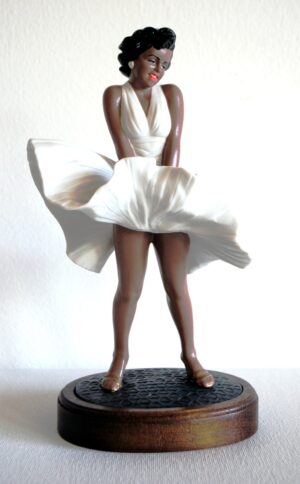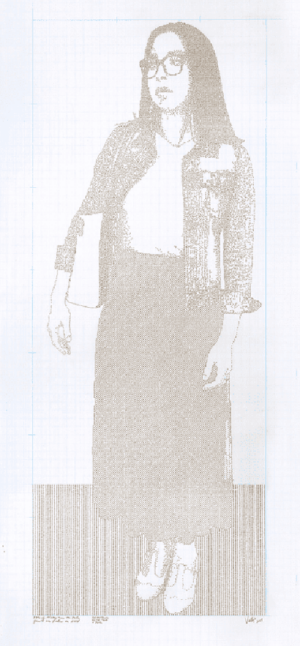Chicana (Mexican American) artist Linda Vallejo combines strategies from conceptual art with research into the state of Latina/os’ lives in the United States to challenge viewers’ stereotypes about people of Latin American descent. Her series, created from 2010 to 2019, called Brown Belongings comprises four separate but related collections of artworks, all committed to representing the lives of Latinos in the realm of the fine arts. These include Make ‘Em All Mexican, The Brown Dot Project, Datos Sagrados, and Cultural Enigma. The Brown Dot Project builds on Make ‘Em All Mexican but offers a new political intervention that marshals the language of minimalism and conceptual art. Such an approach among Chicana/o artists is relatively unusual.
Appropriating Western culture

Linda Vallejo, Marielena La Fabulosa, in Make ‘Em All Mexican, 2012, repurposed porcelain figurine and acrylic, 8.5 x 5 x 4.5 inches (Collection of William Goodman; photo: Linda Vallejo, CC BY-SA 4.0) © Linda Vallejo
In Make ‘Em All Mexican (MEAM), Vallejo employed found objects representing icons of Western culture, painting them brown. She transformed vintage statuettes of Venus, Superman, the Statue of Liberty, and Marilyn Monroe, painted them a rich chocolate brown, and retitled them to reflect their Mexicanness. She described her process as an appropriation of Western culture. Appropriation, by its normal definition, is an act in which more powerful cultures take from the less powerful, a tactic central to colonialism and one that does harm. Vallejo’s reverse appropriation lines up with George Lipsitz’s theory of “strategic anti-essentialism,” a practice in which Western archetypes are taken and transformed as an act of resistance. [1] Imagine a world filled with Brown movie stars, superheroes, and goddesses of love: that world already exists, says Vallejo, using research data to back up her claims.
The Brown Dot Project
In The Brown Dot Project, Vallejo maintains this focus on the growing numbers of Latinos in the United States and their important economic, social, and political roles. She makes that changing world visible but adapts a more minimalist language. Speaking about the Project, she noted, “After creating many MEAM works, I wondered if it would be possible to make a non-figurative work focusing on race and class. I imagined abstract works using the color brown, which eventually grew into an image of brown dots placed on a grid.” [2] As in MEAM, she began The Brown Dot Project by appropriating images, coupling them with research into the lives of Latinos in the U.S. She employed a variety of image types—old photographs, historic postcards, and pictures pulled from the Internet. The Brown Dot Project demonstrates her keen interest in making the Latino population visible but in a more abstract, conceptual manner.

Linda Vallejo, Latinos Made Up 30% of New Nissan Sales in 2014, in The Brown Dot Project, 2019, architectural vellum, archival marker, and pencil, 72 x 28 inches © Linda Vallejo
A 2019 work from The Brown Dot Project titled Latinos Made Up 30% of New Nissan Sales in 2014 is typical. Vallejo began by selecting a seemingly mundane fact as inspiration, making it the title of the work. Next, she appropriated an image from the Internet of a young Latina woman, then printed it on a large, six-foot tall piece of gridded vellum, a type of paper used for architectural drawings. The printed image is soft, with a ghostly aura, and approximately life-size. We see a casually posed young Latina woman, an outwardly spontaneous snapshot-style picture. The figure stands looking to the left, her glance and open mouth activating her, as she acknowledges something off to the side. She carries a large book or notebook under her right arm; a bookmark or note sticking up from its pages suggests that her work has been interrupted. The young woman is casually but professionally dressed, in a skirt, jean jacket, and t-strap shoes. Her glasses lend her an air of intelligence. Vallejo filled in 30% of the squares that comprise the figure with dots, using colored pencil and archival marker, guided by the gridded vellum. The artist thus conceptually renders the title (Latinos Made Up 30% of New Nissan Sales in 2014), enacting and recreating the statistic in order to challenge mainstream viewers’ preconceived notions about Latina/os in the United States, strategies that point to Latinos’ buying power. By choosing a professional-looking Latina woman as the subject, Vallejo upsets mainstream stereotypes of them as predominantly service workers or caretakers. Furthermore, the car brand of the title, Nissan, is Japanese, pointing to Latinos’ impact on the global economy. In fact, if Latino buying power were considered equivalent to a nation’s spending, U.S. Latina/os would be the eighth-largest economy in the world, according to the artist. [3]
A lineage of conceptual and minimalist art
Vallejo’s visual strategies in The Brown Dot Project can be situated within a larger lineage of conceptual and minimalist art, as the artist herself has maintained. She has spoken of the influence of Charles Gaines’s grids, particularly as seen in his 1989 work Numbers and Trees V, Landscape #8: Orange Crow. Venezuelan conceptual artist Eugenio Espinoza whose work Vallejo saw in a show at the Pérez Art Museum Miami in 2015, was a direct inspiration, according to Vallejo. [4] Espinoza’s clean grids, restrained color, and commitment to abstraction inspired Vallejo to think like a Chicana minimalist after spending years on the bold, audacious Make ‘Em All Mexican series (MEAM). Vallejo has much in common with these other conceptual and minimalist artists: a fondness for the grid, an interest in abstraction, a restricted palette, and a fascination with numbers, equations, and ratios. Their work also tends to downplay color, favoring blacks, whites, and grays, although Vallejo’s choice of brown is motivated by her political commitments.
Brown minimalism
Vallejo’s The Brown Dot Project goes beyond conceptualism’s self-aware commentaries on art and artmaking, beyond questioning our investment in representation and reality effects. Her brown minimalism in Latinos Made Up 30% of New Nissan Sales in 2014 is central to the production of meaning. Through minimalist strategies, Vallejo brings the ghostly Latina figure into being, reminding the viewer of the people behind the statistics, giving visual form to Latina/os as the invisibilized force behind the U.S. economy. The work comments on U.S. Latinos’ growing numbers and their economic power. While invested in formalist matters around representation, Vallejo offers high art in the service of Latinx politics, keeping conceptualism and minimalism brown. In other words, her interest in numbers is not simply theoretical or philosophical; her works bring data to the fore in order to combat racism, provoking realizations in the viewer to foster political change.
Scholarly understanding of Chicana/o/x conceptualist and minimalist art is in its nascent state, despite the overall importance of these trends for mainstream art history and criticism. [5] Chicana/o conceptualist and minimalist practices challenge the main narratives or perceptions of the history of Mexican-American’s which has largely focused on muralism, prints, and graphics—though these were central to the Chicano civil rights movement. Vallejo’s work in The Brown Dot Project is also unusual in the wider context of Chicana/o art, as she is one of few Chicana artists of her generation working in a minimalist language. While Vallejo’s conceptual approach is unique, her work aligns well with other Chicana/o/x artists in one key way. Over several generations and through different artistic styles, Chicana/o/x art has been united by the use of visual strategies to counter exclusion. Vallejo employs counter-appropriation to tell visual counterstories or counternarratives, in the process bringing Chicanx and Latinx culture and people to visibility. And like other Chicanx artists, she offers important commentaries on artmaking itself, highlighting the art world’s omissions and suppressions. Minimalism was initially celebrated as an apolitical formalist project, a notion that was challenged by the recognition that the artists were largely white and male. In her work Vallejo tells an expanded, more inclusive story of American art.
This essay is part of Smarthistory’s Latinx Futures project and was made possible thanks to support from the Terra Foundation for American Art.


